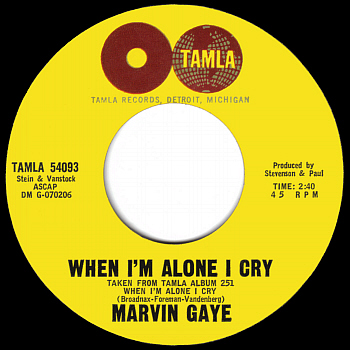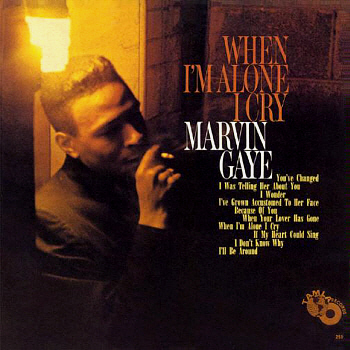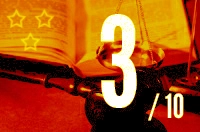Tags
 Tamla T 54093 (B), February 1964
Tamla T 54093 (B), February 1964
B-side of You’re A Wonderful One
(Written by Morris Broadnax, Fredericka Foreman and “Avery Vandenburg“, aka Mickey Stevenson)
 Stateside SS 284 (B), April 1964
Stateside SS 284 (B), April 1964
B-side of You’re A Wonderful One
(Released in the UK under license through Stateside Records)
 Syrupy and sickly, like a double helping of treacle stirred into a pot of honey for no reason at all. This is the quid pro quo Motown exchanged for Can I Get A Witness and You’re A Wonderful One: Marvin Gaye doing what he really wanted to do all along, and using his new-found leverage (as a Hitsville hitmaker and brother-in-law to Berry Gordy) to make sure the label let him do it. Even then, they weren’t sure; the persistent rumour throughout the years has been that Marvin himself had to pick up the tab for these recordings.
Syrupy and sickly, like a double helping of treacle stirred into a pot of honey for no reason at all. This is the quid pro quo Motown exchanged for Can I Get A Witness and You’re A Wonderful One: Marvin Gaye doing what he really wanted to do all along, and using his new-found leverage (as a Hitsville hitmaker and brother-in-law to Berry Gordy) to make sure the label let him do it. Even then, they weren’t sure; the persistent rumour throughout the years has been that Marvin himself had to pick up the tab for these recordings.
This song is the first product we’ve seen of Motown’s new “pseudo-standards” MOR publishing house, ‘Stein and Van Stock Publishing’ – of course, there was no Stein or Van Stock. The company and its writers were deliberately given mainland European, “old line” (or, to put it bluntly, white-sounding) names, with an eye to garnering Motown a greater slice of the all-important sheet music market. The hope was probably that the S&VS hallmark would lead to lucrative re-recording deals on Motown songs, songs that would perhaps find their way into stage show and club repertoires, and become genuine standards in their own right. It never exactly worked, but it wasn’t for want of commitment to the project; here Mickey Stevenson, one of Motown’s most consistent hit-making writer/producers, becomes “Avery Vandenburg” so as not to frighten the racist horses.
All of this suited Marvin right down to the ground, of course. From day one, he’d harboured ambitions to be a glorified, glorious supper-club crooner, the next Nat King Cole, viewing the career in hip-shaking R&B that had made his name and his fortune as first a hindrance, and later a necessary distraction. But now he’d got himself a hit single, Gaye reckoned it was payback time.
 The result was a whole LP of this sort of material, also titled When I’m Alone, I Cry (left), which probably seemed like a good idea at the time but which frankly isn’t much cop at all.
The result was a whole LP of this sort of material, also titled When I’m Alone, I Cry (left), which probably seemed like a good idea at the time but which frankly isn’t much cop at all.
In Marvin’s head, he was both a lover and connoisseur of jazz, possessed of a latent talent for the form: a great jazz vocalist. Almost every time he tried it, though, he ended up squarely (in every sense) in supper-club mode, peddling the softest of soft jazz, the blandest of bland arrangements.
Marvin was a great singer – but not for this kind of material. In this regard, Marvin’s MOR recordings remind me a great deal of Scott Walker, who went down a similar path of self-deluded vocalising in the early Seventies (replace “jazz” with “country and western” as the genre being attempted); but they’re the attempts of an enthusiastic dilettante, the musical equivalents of Michael Jordan declaring himself a baseball pro, and we – the casual listeners – aren’t even compensated with some great performances of ill-suited material. Instead, we’re treated to great artists revealing their blind spots; with a couple of notable exceptions, Marvin’s MOR recordings rarely rise above the competent, the average, the merely decent. This is Marvin Gaye, the R&B superstar, and it’s a waste of his talent to hear him indulging himself in a hobby. As it turned out, nobody wanted to pay good money to hear his vanity projects when they could either be buying actual Marvin Gaye records or records by other, more practised radioland crooners.
When I’m Alone, I Cry is a perfect example of Gaye’s hubris, an illustration of the gap between what he was hearing on the tape and what everyone else was listening to. This is a gloopy, largely shapeless late-Forties supper club pastiche that goes absolutely nowhere and takes too long to get there.
In its favour, Marvin is really in love with the schlocky material, occasionally getting close to his R&B vocal best, deep and intense, before wandering off into blander, more buttery passages. Proof positive, perhaps, that a great voice can render even the dullest musical wallpaper briefly compelling. But not nearly enough to save this.
A bit of a mess, all told – but unfortunately for Motown, not enough of a mess to convince Marvin Gaye he’d never make it in these particular dangerous waters.
MOTOWN JUNKIES VERDICT
(I’ve had MY say, now it’s your turn. Agree? Disagree? Leave a comment, or click the thumbs at the bottom there. Dissent is encouraged!)
You’re reading Motown Junkies, an attempt to review every Motown A- and B-side ever released. Click on the “previous” and “next” buttons below to go back and forth through the catalogue, or visit the Master Index for a full list of reviews so far.
(Or maybe you’re only interested in Marvin Gaye? Click for more.)
 |
 |
| Marvin Gaye “You’re A Wonderful One” |
The Contours “Can You Do It” |
DISCOVERING MOTOWN |
|---|
Like the blog? Listen to our radio show! |
| Motown Junkies presents the finest Motown cuts, big hits and hard to find classics. Listen to all past episodes here. |


Totally agree with you on this track’s relative merits, but man, that’s one great LP cover!
LikeLike
It really is quite lovely, isn’t it? A shame the actual LP inside it isn’t up to the standards of the jacket.
LikeLike
Yes I remember. You turned this 45 over and were quickly wondering what the hell happened to the great guy you were just listening to.
According to David Ritz, Marvin was obsessed with giving the ‘correct’ interpretation of standards instead of remaking them in his own image and stamping his real personality on them.
In stark contrast, later in the decade, Aretha would apply exactly that approach. Her version of “Somewhere” from West Side Story (on her “Hey Now Hey” album) is magnificent and memorable, the best non-single track on that album probably. But you could never imagine Natalie Wood or Richard Beymer singing it that way in the movie! Aretha’s version is hers alone and sounds like no one else’s. Or have a listen to her take of “Gentle On My Mind” (her “Soul ’69” album) the song that first gave Glen Campbell some national notice. His was rather bland, inoffensive, almost a lullaby; hers is a confident and assertive uptempo stomp, with the background girls pushing her all the way, and hers would remind no one of Campbell. I love it.
It might also be noted that in 1964 Marvin was only turning 25 that spring, and much of the despair and melancholy in many of these standards are more suited to singers you know are glancing back from decades of hard knocks and see-sawing luck. Those times would certainly come for Marvin, but he’s too young yet to give sincerity to tales of settled cynicism or seasoned bitterness.
LikeLiked by 1 person
I’ve never heard this one, but the dreadful presence of ‘What Kind of Fool Am I?’ on the Motortown Review LP persuades me that I’m not missing much. The liberating and life-enhancing pulsation of ‘Can I Get a Witness’ and ‘Heat Wave’ provided an excellent foil for Mozart and Mahler, sending me back to them with renewed gusto; but the dreariness of such MOR dreck drives me straight back to Stravinsky (or Martha, or those Japanese drummers, or Il Trovatore, or very nearly ANYTHING else.) There’s not much in music which I passionately dislike, but ‘What Kind of Fool Am I’ (along, let’s say, with all the music from ‘Cats’ -) pretty well encapsulates my allergies, and I’m not masochistic enough to explore further – though the LP jacket, as Nick remarks, is certainly enticing. Bring on the Contours!
LikeLike
When I first heard this track back in 1964, I thought that it was music suitable only for the old folks. Now it’s 47 years later, and I still don’t feel old enough to appreciate it.
LikeLiked by 1 person
The company and its writers were deliberately given mainland European, “old line” (or, to put it bluntly, white-sounding) names, 0r more bluntly–Jewish sounding names.
LikeLike
Is it okay if I vent for a minute? I wish Gordy/Motown hadn’t been so obsessed with his singers going “broadway, etc”. This really came out in concerts. In 1968-71 I saw concerts by Diana Ross & Supremes, Temptations & Smokey & the Miracles. I was a pre-teen then & was expecting my favorite artists to do all their hits during their concerts. What I got instead was a few hits (mostly relegated to medleys) & a bunch of showtunes/standards/hits of the day etc. Yes, the artists adequately performed these numbers but I went to hear their own songs. I do understand Gordy wanting to take his artists off the chitlin circuit & into the Copas, etc but to me it all came out as “the Sound of Middle Aged Suburban America”. I feel the same way about most of the TV specials like TCB. All glitz but very little soul. Again everything was very professionally done but I just wasn’t into it. Any thoughts from anyone? And please know I mean no ill will towards Mr. Gordy or anyone else involved with this. This is simply my opinion. Okay I feel much better now that I’ve done my ranting. Oh yeah, at the Miracles concert, Smokey did “Theme from Love Story” & a girl in my row shrieked & went nuts! Oh yeah & the Supremes’ opening act was the Baja Marimba Band! What was up with that? Oh well!
LikeLiked by 1 person
I agree with you four square. Even back then, I kind of knew what Gordy was aiming for: the ever-expanding product to reach an ever-expanding market, resulting on more and more $$$$. The only problem was that he was doing it at my expense! That’s not why I was paying my hard-earned dough to attend these exhibitions. I wanted to hear the hits and the R&B album cuts that drew me to the shows, not that Broadway crap! And when I heard that stuff during the TV specials, my reaction was consistent: bathroom time!
I would like to think that these concert add-ons were done for strictly monetary reasons and not that Gordy feared that mass audiences could handle only so many R&B servings at one dinner. I really don’t know. I haven’t done the research by reading all the books.
LikeLike
The irony is that of all the songs held under Stein & Van Stock copyright, one actually did become a genuine MOR standard, years after this miss: “For Once in My Life,” written by Ron Miller and Orlando Murden, by dint of Tony Bennett’s 1967 cover. The reviews of this song – implying that it was an older composition of the era Bennett excelled in – were exactly what Gordy had been hoping and aiming for with respect to his little ASCAP affiliate (or “AS,” as many a US Decca LP or 45 of the late 1950’s to early ’70’s, would put it).
But the Stein & Van Stock name, I thought had indeed been an old-line publisher, based out of Detroit (whose existence dated to the early years of the auto industry), that Gordy had taken over (as, indeed, by 1968 he would do with Ed Wingate’s recording studios and record labels [i.e. Ric-Tic, Golden World] whose artists would then be absorbed amongst the Motown labels [most notable being Edwin Starr who went to Gordy]). That the whole Stein & Van Stock enterprise was made up by Gordy and Stevenson somehow comes as no surprise, in the end.
And as for this track (and “If My Heart Could Sing”) – the one thing that stood out in my mind, to this day, is that on the 45, as the last notes fade out, the tape abruptly cuts out before the natural delay.
LikeLike
Sinatra-like Lp cover, Sinatra-like material. How come nobody likes?
It sounds like a recitation is why. It’s do forgettable i only flipped it over once and never bothered repeating my mistake.
LikeLike
Yes, it’s syrupy. I would have preferred just Marvin, his piano, bass, drums and a guitar, rather than his voice fighting for air with that ham fisted string section.
That out of the way, I love this album. It’s a great late summer evening with a cocktail record. (The strings are a bit shrill for getting “In the mood”.)
If Motown had allowed an outside producer or enlisted someone like Billy May to do the arrangements, I think this album would have been a marvellous zingy affair.
Bob
LikeLike
Little did Marvin know he would be very successful (probably the most) at blending jazz and soul in the 70’s. Marvin Gaye is the greatest musician to ever grace this earth. I wish songs like this didn’t exist though lol
LikeLike